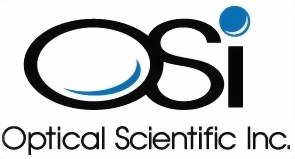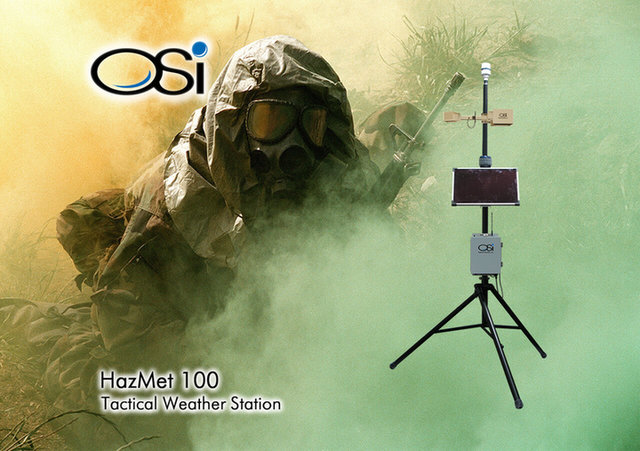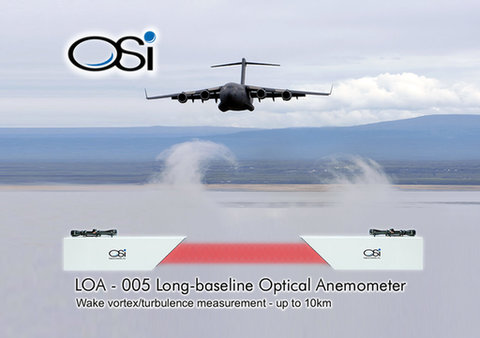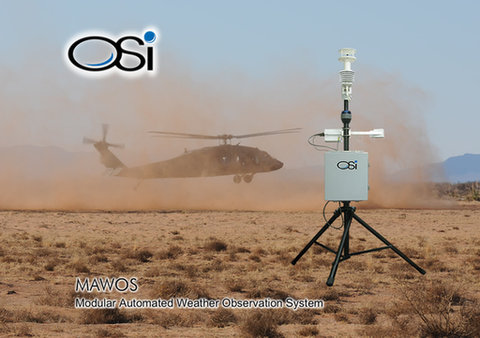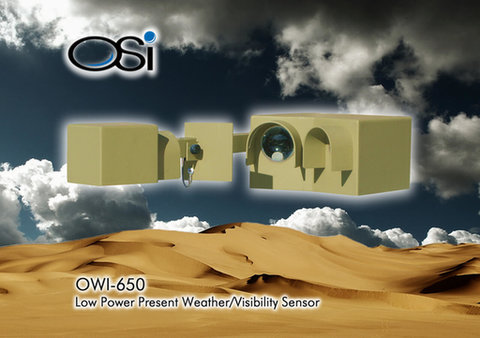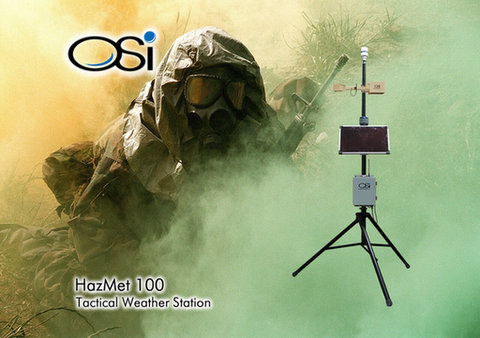Weather Sensors and systems for tactical response
Building on over 30 years of ground-breaking research with NASA, NOAA, U.S. Army, U.S. Air Force, and many others, Optical Scientific, Inc‘s. product line of air/gas flow sensors, present weather sensors, and AWOS systems are recognized as leaders in the global market with thousands installed worldwide. We are proud of our reputation for accuracy and rugged reliability.
In 1981 Dr. Ting-I Wang, working at the NOAA ERL Wave Propagation Laboratory published a seminal paper: Wind Measurements By Temporal Cross-Correlation Of Optical Scintillations showing how this method could be used to measure changes in air flow just by analyzing the movement of air through a beam of light. Other papers refining this approach soon followed, along with grant of original US patents using this approach for weather data collection of unprecedented accuracy.
In 1985, Dr. Wang formed Scientific Technology Inc, to put this unique approach to work in the gathering of weather data, resulting in the successful development of optically-based precipitation and present weather sensors now in use in every environment in the world.
Constant research and development led to more patent grants and ever more sophisticated instruments. In 1999, to reflect the growing capabilities and expansion of the business model, the company name was changed to Optical Scientific, Inc. Today OSI offers weather sensors, stand-alone automated weather observation systems, and air/gas/steam flow sensors.
These have found a variety of uses in data reporting for NASA, NOAA, US Army, US Air Force, along with Sandia, and Argonne National Laboratories. State, local governments and commercial ventures also put the sensors to work at airport operations, ground transportation, shipboard and industrial applications.
Besides scientific, commercial, and industrial uses, OSI has recognized and supported the military need for accurate real-time data in air and ground operations, especially where portability and rapid deployment are required. OSI has designed these sensors and systems for immediate local use with quick setup and removal – or completely mobile. They are capable of operating on battery or solar power, require no special tools, and are easily transported or packed in to remote locations to provide tactical support.
- Atmospheric and weather sensors for remote sensing and environmental monitoring
- Modular Automated Weather Observing Systems (MAWOS) scalable for every application from helipad to international airport.
- Long range Optical Anemometers (LOA) for large scale crosswind and turbulence detection
OWI-650
Also known as LPWIVIS (Low Power Weather Indicator Visibility Sensor) OWI-650 is a miniaturized version of our renowned OWI-430. Developed for the US Army, it can report more than 50 NWS and WMO codes, and visibility conditions up 10+ km. It can operate with battery or solar cell, and can be hand-carried anywhere.
HazMet 100
HazMET100 system is an atmospheric sensor station designed to be used in the event of a hazardous chemical release, environmental emergency, or gas attack. Especially configured to work with EPA’s ALOHA dispersion modeling program, HazMET100 can be deployed and transmitting atmospheric data to a distant monitoring base within minutes. With optional OWI-650 it can be easily transformed into a portable tactical weather station.
MAWOS
MAWOS (Modular Automated Weather Systems) offers intelligent algorithms based on over 200 million hours of sensor field data and meet all NWS, WMO, FAA, and Canadian guidelines. The modular design is easily configured to customer specifications. MAWOS is designed to FAA Advisory Circular 150-5220.16D and Canadian CAR 804.01(c) Options from simple AWOS A to AWOS IIIP are offered. All MAWOS can be equipped with multilingual voice reporting, VHF ground-to-air radio, telephone, cell phone, and Ethernet interface.
LOA - 005
The Long-baseline Optical Anemometer measures path-averaged crosswind and turbulence from distances of 100 meters to over 10 km. LOA provides true remote sensing of turbulence and crosswind measurement for applications including perimeter monitoring, artillery calculations, image enhancement and aircraft wake vortex measurement.
Optical Scientific, Inc. began as a small tightly-knit company serving a predominantly U.S. customer base. Today it is still tightly knit - serving thousands of customers from mining to aerospace in every part of the globe. Our progress has been due to our constant effort to meet our customer’s needs: military, scientific, civil, commercial or industrial. We take pride in our history of original research, innovative thinking, supporting our customers, and - simply making the best products we can.
OSI sensors and systems are designed to be as flexible and as easy to integrate as possible. Still, you might have a requirement we haven’t thought of. Let us put our knowledge and expertise in the military/tactical arena to work for you.
Weather Sensors and systems for tactical response
Building on over 30 years of ground-breaking research with NASA, NOAA, U.S. Army, U.S. Air Force, and many others, Optical Scientific, Inc‘s. product line of air/gas flow sensors, present weather sensors, and AWOS systems are recognized as leaders in the global market with thousands installed worldwide. We are proud of our reputation for accuracy and rugged reliability.
In 1981 Dr. Ting-I Wang, working at the NOAA ERL Wave Propagation Laboratory published a seminal paper: Wind Measurements By Temporal Cross-Correlation Of Optical Scintillations showing how this method could be used to measure changes in air flow just by analyzing the movement of air through a beam of light. Other papers refining this approach soon followed, along with grant of original US patents using this approach for weather data collection of unprecedented accuracy.
In 1985, Dr. Wang formed Scientific Technology Inc, to put this unique approach to work in the gathering of weather data, resulting in the successful development of optically-based precipitation and present weather sensors now in use in every environment in the world.
Constant research and development led to more patent grants and ever more sophisticated instruments. In 1999, to reflect the growing capabilities and expansion of the business model, the company name was changed to Optical Scientific, Inc. Today OSI offers weather sensors, stand-alone automated weather observation systems, and air/gas/steam flow sensors.
These have found a variety of uses in data reporting for NASA, NOAA, US Army, US Air Force, along with Sandia, and Argonne National Laboratories. State, local governments and commercial ventures also put the sensors to work at airport operations, ground transportation, shipboard and industrial applications.
Besides scientific, commercial, and industrial uses, OSI has recognized and supported the military need for accurate real-time data in air and ground operations, especially where portability and rapid deployment are required. OSI has designed these sensors and systems for immediate local use with quick setup and removal – or completely mobile. They are capable of operating on battery or solar power, require no special tools, and are easily transported or packed in to remote locations to provide tactical support.
- Atmospheric and weather sensors for remote sensing and environmental monitoring
- Modular Automated Weather Observing Systems (MAWOS) scalable for every application from helipad to international airport.
- Long range Optical Anemometers (LOA) for large scale crosswind and turbulence detection
OWI-650
Also known as LPWIVIS (Low Power Weather Indicator Visibility Sensor) OWI-650 is a miniaturized version of our renowned OWI-430. Developed for the US Army, it can report more than 50 NWS and WMO codes, and visibility conditions up 10+ km. It can operate with battery or solar cell, and can be hand-carried anywhere.
HazMet 100
HazMET100 system is an atmospheric sensor station designed to be used in the event of a hazardous chemical release, environmental emergency, or gas attack. Especially configured to work with EPA’s ALOHA dispersion modeling program, HazMET100 can be deployed and transmitting atmospheric data to a distant monitoring base within minutes. With optional OWI-650 it can be easily transformed into a portable tactical weather station.
MAWOS
MAWOS (Modular Automated Weather Systems) offers intelligent algorithms based on over 200 million hours of sensor field data and meet all NWS, WMO, FAA, and Canadian guidelines. The modular design is easily configured to customer specifications. MAWOS is designed to FAA Advisory Circular 150-5220.16D and Canadian CAR 804.01(c) Options from simple AWOS A to AWOS IIIP are offered. All MAWOS can be equipped with multilingual voice reporting, VHF ground-to-air radio, telephone, cell phone, and Ethernet interface.
LOA - 005
The Long-baseline Optical Anemometer measures path-averaged crosswind and turbulence from distances of 100 meters to over 10 km. LOA provides true remote sensing of turbulence and crosswind measurement for applications including perimeter monitoring, artillery calculations, image enhancement and aircraft wake vortex measurement.
Optical Scientific, Inc. began as a small tightly-knit company serving a predominantly U.S. customer base. Today it is still tightly knit - serving thousands of customers from mining to aerospace in every part of the globe. Our progress has been due to our constant effort to meet our customer’s needs: military, scientific, civil, commercial or industrial. We take pride in our history of original research, innovative thinking, supporting our customers, and - simply making the best products we can.
OSI sensors and systems are designed to be as flexible and as easy to integrate as possible. Still, you might have a requirement we haven’t thought of. Let us put our knowledge and expertise in the military/tactical arena to work for you.
